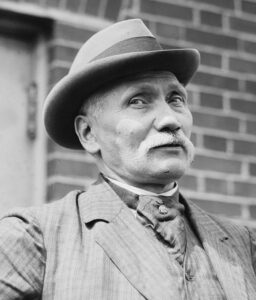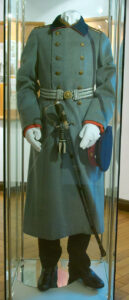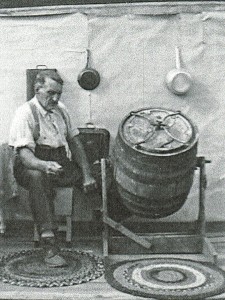shoemaker

 George Lane was a shoemaker by trade, back in the mid 1800s. He also had a birth defect, that earned him the nickname he hated all his life…Clubfoot. In an event that seems rather unusual to me, Lane was accused of being a member of Henry Plummer’s gang of “Innocents” and was hanged by Montana Vigilantes in January 1864. Lane was a small man, originally from Massachusetts. He later made his way to the west during the California Gold Rush. Like many people back then, he dreamed of becoming rich, and the Goldrush seemed as likely a way as any other. Things didn’t exactly go as planned, and he ended up working first on a farm in Yuba County, before making his way to Calaveras County, where he worked as a store clerk. Not quite the glamorous outcome he had in mind.
George Lane was a shoemaker by trade, back in the mid 1800s. He also had a birth defect, that earned him the nickname he hated all his life…Clubfoot. In an event that seems rather unusual to me, Lane was accused of being a member of Henry Plummer’s gang of “Innocents” and was hanged by Montana Vigilantes in January 1864. Lane was a small man, originally from Massachusetts. He later made his way to the west during the California Gold Rush. Like many people back then, he dreamed of becoming rich, and the Goldrush seemed as likely a way as any other. Things didn’t exactly go as planned, and he ended up working first on a farm in Yuba County, before making his way to Calaveras County, where he worked as a store clerk. Not quite the glamorous outcome he had in mind.
In 1860, gold was discovered in Washington Territory, and Lane once again followed the miners, with plans to “get rich quick” forming in his head. Again, Lane ran into trouble. This time in 1862 when a Lewiston, Idaho rancher accused him and another man of “running off horses.” That “crime” didn’t really seem as serious as the rancher supposed, but then I am not a lawman. Wanting to straighten things out, Lane turned himself into the Fort Lapwai commander, who assigned them to help with building construction. The following year, he and another man were accused of a similar crime, this time, driving a stolen horse herd toward the Snake River. The alleged horse thieves escaped, and by the fall of 1863, Lane had made his way to Virginia City, Montana. His situation and the oddly recurring events, make you wonder if he was as innocent as he claimed. He did, after all, run from the law his time. He soon went to work for Dance and Stuwart’s Store, mending harnesses and making and repairing boots. It would appear that he was at least trying to lead an honest life.
Lane began earning the respect of his employers. Nevertheless, he again came under suspicion when he rode to Bannack, Montana, to inform Henry Plummer of the George Ives trial taking place in Nevada City in December 1863. Though Plummer was absent at the time, Lane told Deputies Ray and Stinson of the growing vigilance movement in Virginia City. It would seem to me that when you are suspected of being a part of a criminal gang, that should be the furthest thing from your thoughts, if you want to look innocent anyway. Because of that trip, when the Vigilance Committee met the following month, Lane’s name immediately came up as a “spy” for the outlaw gang called The Innocents.
On January 14, 1864, Lane was arrested at Dance and Stuart’s store. When he asked why he was being arrested, the men informed him, “For being a road agent, thief, and an accessory to numerous robberies and murders on the highway.” Lane responded by saying, “If you hang me, you will hang an innocent man.” While his bosses liked and respected Lane, they assumed that the vigilantes had evidence against Lane, so they did not intervene. Not everyone thought Lane was guilty, but the Committee tried him anyway and found him guilty. He was sentenced to be hanged along with Frank Parish, Boone Helm, Haze Lyons, and Jack Gallager. Lane requested a minister be brought before he was executed which was scheduled to be the first execution. Then, as he was forced to stand on a box under the noose, Lane saw a friend. He yelled out, “Goodbye, old fellow; I’m gone.” He then leaped from the box without waiting for it to be removed…going out on his own terms. He and the others hanged that day were buried in Virginia City’s Boot Hill Cemetery. As punishment, none of the graves were given markers.
Placing no markers while maybe a “fitting punishment” can later pose a problem. Weh people began to ask who 
 was in these graves, some 43 years later, it brought in question the deaths. In 1907, a former vigilante came forward, saying that he knew the order of the graves, and which one was Club Foot George’s. Their curiosity peaked now, the city soon dug up the grave that was allegedly Clubfoot George Lane’s. Everyone was surprised when he had been right. The deformed foot belonging to George Lane was indeed in the grave. The foot bones were then placed in a cabinet in the courthouse. Later, they were moved and placed on display in a glass jar at the Thompson Hickman Museum in Virginia City, Montana.
was in these graves, some 43 years later, it brought in question the deaths. In 1907, a former vigilante came forward, saying that he knew the order of the graves, and which one was Club Foot George’s. Their curiosity peaked now, the city soon dug up the grave that was allegedly Clubfoot George Lane’s. Everyone was surprised when he had been right. The deformed foot belonging to George Lane was indeed in the grave. The foot bones were then placed in a cabinet in the courthouse. Later, they were moved and placed on display in a glass jar at the Thompson Hickman Museum in Virginia City, Montana.

 Sometimes, you come across someone so bold and so outrageous in their actions, that you are left in complete shock. Now, I can’t say that I am the one in complete shock, but I suspect that a squad of German soldiers might have been, when on October 17, 1906, Wilhelm Voigt, a 57-year-old German shoemaker, decided to impersonate an army officer and lead an entire squad of soldiers to help him steal 4,000 marks. When calculated to American dollars and to 2023, that would be approximately $33,000. While Voigt was a shoemaker by trade, he also had a long criminal record as a thief. So, he carefully planned the robbery, knowing that the German soldiers had a long history of blind obedience.
Sometimes, you come across someone so bold and so outrageous in their actions, that you are left in complete shock. Now, I can’t say that I am the one in complete shock, but I suspect that a squad of German soldiers might have been, when on October 17, 1906, Wilhelm Voigt, a 57-year-old German shoemaker, decided to impersonate an army officer and lead an entire squad of soldiers to help him steal 4,000 marks. When calculated to American dollars and to 2023, that would be approximately $33,000. While Voigt was a shoemaker by trade, he also had a long criminal record as a thief. So, he carefully planned the robbery, knowing that the German soldiers had a long history of blind obedience.
Voigt got his hands on a captain’s uniform and hatched a plan to manipulate the German army into following his lead, thereby exploiting their blind obedience to authority and making them assist in his crazy robbery scheme. Voigt approached a troop of soldiers in Tegel, Germany. Just outside Berlin, he boldly ordered the unit to follow him 20 miles into the town of Kopenik. The group had lunch, and then Voigt put the men in position and stormed into the mayor’s office. They proceeded to arrest the mayor. He demanded to see the cash box and 
 confiscated the 4,000 marks inside. The mayor was put in a car, and Voigt ordered that he be delivered to the police in Berlin. Just like that, the mayor was under arrest…by an imposter.
confiscated the 4,000 marks inside. The mayor was put in a car, and Voigt ordered that he be delivered to the police in Berlin. Just like that, the mayor was under arrest…by an imposter.
And the misfit squad of soldiers proceeded to Berlin, Voigt managed to disappear with the money. No one noticed that he had gone, and it took more than a few hours at the police station before everyone realized that it was all a hoax. As for the Kaiser…well, he thought the story was funny, but They had been humiliated by the man who was obviously impersonating a captain. They launched a massive campaign to find Voigt. They wanted revenge for the fact that they were fooled. Voigt was caught in Berlin a few days later. Voigt was found guilty and was sentenced to four years for the robbery. Somehow, the Kaiser himself pulled some strings to get him out in less than two. While he was a convicted criminal after that, the people considered him a bit of a hero for the rest of his life. He even posed for pictures for years. His little ruse, while considered a crime by the Germans, made Voigt famous.
 Not everyone who belongs in a family history is a family member. It seems fitting to me to talk about the Hoover family, because they played a rather large part in our family’s history, and therefore were as close as family. In her young years, my great aunt, Bertha Matilda Spencer and her mother did not get along. The situation continued to be a problem for some time, and at some point it became intolerable.
Not everyone who belongs in a family history is a family member. It seems fitting to me to talk about the Hoover family, because they played a rather large part in our family’s history, and therefore were as close as family. In her young years, my great aunt, Bertha Matilda Spencer and her mother did not get along. The situation continued to be a problem for some time, and at some point it became intolerable.
I don’t know how old Bertha was when she went to live with the Hoover family, or if it was her decision or her mother’s, but she never lived at home again. Many people might think that hers was a horribly sad and lonely life after that, but to me she looked genuinely happy. That makes me think that possibly her move to the Hoover home was something that was by mutual agreement, between her and her mom, but I still have to wonder if the whole situation made my great great grandfather rather sad. I don’t know about Great Great  Grandma, but the rest of the family, it seems, was very close to the Hoovers…leading me to think that they missed their sister very much. Because the Hoover family was so close to his, my grandfather remained friends with them for the rest of his life, even having his picture taken with two of the Hoover boys, Ed and Joe, two years before his death.
Grandma, but the rest of the family, it seems, was very close to the Hoovers…leading me to think that they missed their sister very much. Because the Hoover family was so close to his, my grandfather remained friends with them for the rest of his life, even having his picture taken with two of the Hoover boys, Ed and Joe, two years before his death.
Mr Hoover’s name was France, and while he was a farmer by trade, he also had the ability to repair and maybe even make shoes for his family. I suppose a lot of families learned trades to help save their families money, but shoemaking is something that seems such a strange hobby these days. Of course, for France Hoover, it was not a hobby, it was a necessity. His family needed shoes, and to purchase them was expensive. I found these pictures to be very interesting, as I thought about how the shoes were made or repaired in those days. They were all hand crafted, unlike the shoes of today that are mass produced by machines. The shoes were made out of leather, while most shoes today are made out of synthetic materials. I have a feeling those shoes lasted much longer than our shoes today do too.
Shoes then were not designed for looks so much, but rather they were made in a  practical fashion, which would have saddened me, because I love my high heels, and I love different designs and colors. Shoes of yesteryear were quite different, and I’m sure the shoemakers would have thought of me as being half crazy. Maybe I am, but I would be in good company, I think, because there are a whole bunch of us high heel fanatics in this world. These are just different times than those were, and since they most likely had just one pair of shoes, compared to my 50 or more, theirs had to be built to last. While France Hoover was not related to me, I still find him to be an interesting character from the past. Some things he did the old fashioned way, like making and repairing shoes, and some things like cars and tractors, he had to have the latest innovations available. I suppose it just depends on where your priorities are, really, and I’m quite certain that mine are vastly different than France Hoover’s were.
practical fashion, which would have saddened me, because I love my high heels, and I love different designs and colors. Shoes of yesteryear were quite different, and I’m sure the shoemakers would have thought of me as being half crazy. Maybe I am, but I would be in good company, I think, because there are a whole bunch of us high heel fanatics in this world. These are just different times than those were, and since they most likely had just one pair of shoes, compared to my 50 or more, theirs had to be built to last. While France Hoover was not related to me, I still find him to be an interesting character from the past. Some things he did the old fashioned way, like making and repairing shoes, and some things like cars and tractors, he had to have the latest innovations available. I suppose it just depends on where your priorities are, really, and I’m quite certain that mine are vastly different than France Hoover’s were.

